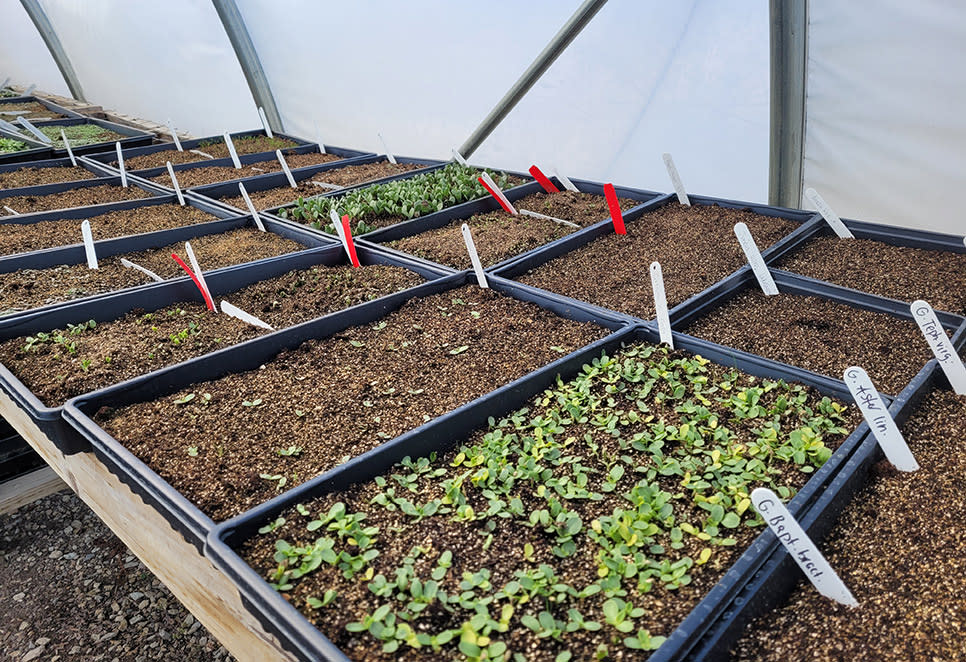Trudging through the cold north winds on an early March morning, icy rains slashing my face, I make my way from the parking lot to the Kankakee Sands greenhouse. Clomp-clomp, clomp-clomp. I slide open the greenhouse door and am instantly transported to a state of bliss – the warmth, the fresh moist smell of dirt and seedlings that tickles my nose, and the gentle whir of the fan that makes the seedlings dance in the breeze. I take an enormous deep breath, and then it’s time to get to work.
Inside the Kankakee Sands greenhouse are 26 rectangular germination trays filled with a fine texture potting soil. Sprinkled on top are the seeds from 26 different species of native plants. These are tomorrow’s prairie. The small seeds, just now splitting their seed coats and sending their pointed white root tip downward and a light green slender shoot upward, are plants native to Northwest Indiana. In just a few weeks’ time, there will be thousands of seedlings needing me to transplant them with extreme care and intention. They are the less common prairie plants, the “fancy” plants as I like to call them.
These “fancy plants” are the rare species of our Indiana prairies. Most of these plants would have grown in high quality, diverse remnant prairies – never plowed for agriculture, a prairie since the retreat of the glaciers. It’s been 20 years since we first began the conversion of Kankakee Sands agricultural fields to high-quality prairies with more than 600 different types of prairie plants. But some of the native prairie plants, namely the “fancy” plants, are not showing up in the numbers that we would like to see nor the numbers that nature needs in order to swing the scale back into balance.

Lead plant (Amorpha canescens) is one such fancy plant that we are growing in the KS greenhouse this year because we see so few of them establishing in our prairies. Lead plant is a slow growing, perennial, native Indiana shrub. It grows approximately 3 feet in height and 2 feet wide. The finely divided leaves are leaden in color and almost fernlike in appearance. Small purple flowers with orange tipped anthers rise in rows along a central spike.
Lead plant begins to send new green growth out from its woody stems in May. Flowering time is typically late June and July, then seed formation in August and September. It will continue to stay green, absorbing sunlight and making more chlorophyll to replenish its rootstock for next year, until the frosts of October.
Lead plant is typically found on sand, gravel and hill prairies, as well as limestone glades and black oak savannas. Lead plants is one of the characteristic trademarks of a high-quality prairie that has been functioning for many years.
There is a native moth, the aptly named leadplant flower moth (Schinia lucens), that feeds solely on lead plant. The leadplant moth’s previous range was all throughout the Midwest, wherever its host shrub grew. But with the challenges of habitat fragmentation and habitat loss, the leadplant flower moth becomes more and more difficult to find. Not yet documented from Kankakee Sands, it was seen in 2003 at Iroquois County Conservation Area in Illinois, just a few miles southwest of Kankakee Sands. So, there is hope!
Bringing lead plant, and these other 26 “fancy” plants back to the landscape is just one more small step towards restoring the balance in our natural world. When we bring back the plants, we can also bring back the other species, like moths, butterflies, and beetles that depend on them for life.
The good news is that you too can lend a hand in restoring the balance to our natural world.
Doug Tallamy, author of Bringing Nature Home, has coined the term Homegrown National Park TM – “a grassroots call to action to restore biodiversity and ecosystem function by planting native plants and creating new ecological networks.” Check out www.homegrownnationalpark.org. Simply by choosing to plant native plants in your yard, in pots on your porch, in community gardens, or at community centers, you are providing food and nectar sources for our smaller creatures that can’t move fast or far and can’t cover miles at a time, yet can move, ever so slowly and surely along, generation after generation, mile by mile, yard by yard, to large swaths of habitat where they can thrive. You have the power to create corridors by which our native animals can travel. The simple act of planting native plants and reducing your pesticide use to keep those pollinators pollinating will make all the difference.
As I tend to the lead plant growing in the greenhouse, eventually potting them up into larger pots, and later transplanting the plants into habitat at Kankakee Sands, I can’t help but think that maybe someday we will see the leadplant moth, in all its zigzag ruby red glory in our Newton County. I know it may be a long way off, but come July, I’ll be keeping watch on the leadplant flowers just in case. You never know, success could be even closer than we think.
The Nature Conservancy’s Kankakee Sands is an 8,300-acre prairie and savanna habitat in Northwest Indiana, open every day of the year for public enjoyment. For more information about Kankakee Sands, visit www.nature.org/KankakeeSands or call the office at 219-285-2184.
More Kankakee Sands Blogs
Nature Notes: Bison, by the Numbers, at Kankakee Sands
- 4 min read
It’s that exciting time of the year when the bison calves are born! At the close of 2020, we had 93…
Nature Notes: Hoary Vervain at Kankakee Sands
- 3 min read
A Crowd Pleaser I overlook things all the time – but insects don’t. I walk, bike and drive…
Nature Notes: Chatty Little Grasshopper Sparrows at Kankakee Sands
- 4 min read
Header photo by Kathy Malone Nature isn’t always what it seems – a chatty little…
Nature Notes: The Smell of Spring - Skunk Cabbage at Kankakee Sands
- 3 min read
After a long gray Indiana winter, it’s a real joy to smell skunk cabbage (Symplocarpus foetidus), one…
Nature Notes: Growing the Fancy Plants at Kankakee Sands
- 5 min read
Trudging through the cold north winds on an early March morning, icy rains slashing my face, I make my way…
Nature Notes: I Love Winter at Kankakee Sands
- 3 min read
Photo by Jessica Gomez TNC With its short days, grey skies and cold temperatures, February in Indiana can…
Nature Notes: Crossing Those Lines - Migrating Monarchs
- 3 min read
Photos by Trevor Edmonson This past September, upwards of 2,000 monarchs congregated on the oak trees growing…
Nature Notes: Grounded - Leopard Frogs at Kankakee Sands
- 4 min read
Northern leopard frogs are fast, real fast! They aren’t called leopard frogs for nothin’. They…
Nature Notes: One Bat, Two Bat at Kankakee Sands
- 3 min read
This spring we were delighted to look up and find that our furry, winged, big brown bat mascot was hanging…
Nature Notes: Royal Confusion - Butterflies at Kankakee Sands
- 5 min read
Header photo: Viceroy Butterfly by Ryan Rasmussen/TNC In early September, our Kankakee Sand prairies are…













